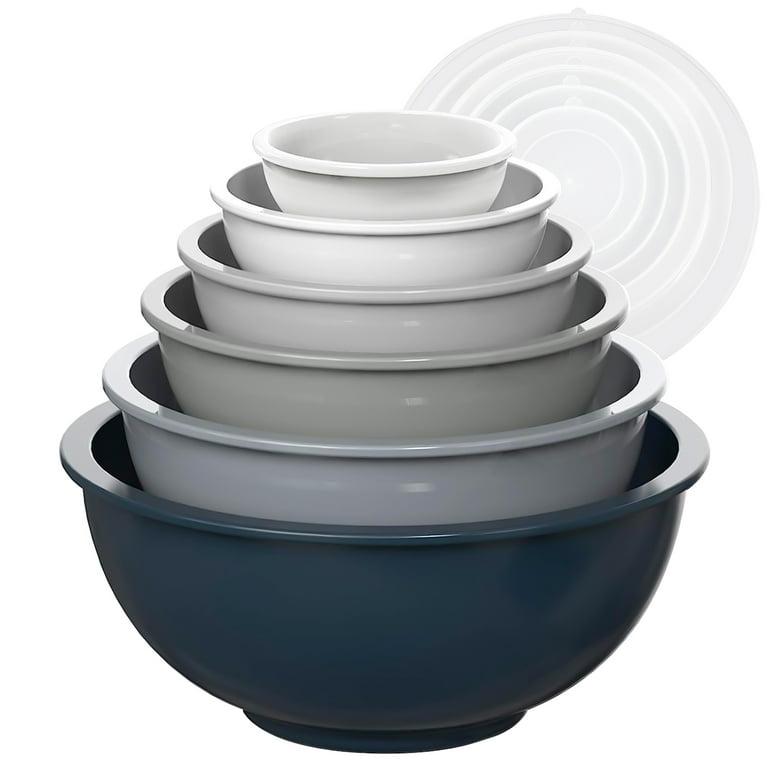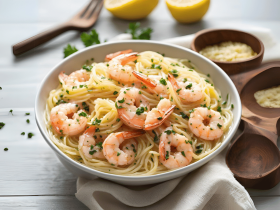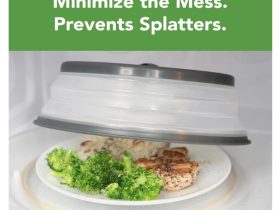Choosing the right microwave safe mixing bowls for your kitchen is crucial, especially when you frequently use the microwave for cooking or reheating food.
A microwave safe mixing bowl is typically made from materials like glass, ceramic, or certain plastics that can handle the heat generated by microwaves without leaching chemicals into your food or warping.
Microwave safe mixing bowls with lids are also a handy option, keeping your food secure and ready for storage right after mixing.
These bowls often come with labels or symbols indicating their microwave safety, making them easy to identify. Having a set of these in your kitchen not only simplifies meal prep but also contributes to a safer cooking environment.
They are versatile, durable, and an essential tool for any home cook who values convenience and safety in the kitchen. They are versatile, durable, and an essential tool for any home cook who values convenience and safety in the kitchen.
For additional uses, consider mixing bowls oven safe, as some glass and ceramic bowls can serve dual purposes.
Importance Of Microwave Safe Mixing Bowl
Mixing bowls are important in every kitchen. Some bowls are safe for the microwave, and some are not. Using the wrong bowl in the microwave can be dangerous. This is why knowing which bowls are safe is very important.
OXO mixing bowls dishwasher safe options are also available, along with OXO mixing bowls microwave safe varieties, making them an excellent investment for frequent home cooks.
Health Risks
Using the wrong bowls in the microwave can cause health problems. Here are some reasons:
- Chemicals can mix into your food. Some bowls have harmful chemicals. Heat makes these chemicals mix into your food.
- Hot spots can burn you. Bowls not meant for the microwave can get very hot. They can burn your hands or even start a fire.
- Broken pieces can be dangerous. If a bowl breaks in the microwave, it can cut you. Always use bowls that are safe.
Material Concerns
Different materials act differently in the microwave. Here are some materials to know about:
| Material | Safe or Not? |
| Glass | Mostly safe |
| Plastic | Some are safe, some are not |
| Ceramic | Usually safe |
| Metal | Not safe |
Always check the bottom of the bowl. It should say if it’s safe for the microwave. If it doesn’t say, it’s better not to use it in the microwave. Safety is very important.

Credit: www.walmart.com
Types Of Safe Mixing Bowl Materials
Choosing the right mixing bowls for your kitchen is important. Microwave safe bowls make cooking easier and safer. Materials matter when you heat food in the microwave. Some materials can handle heat well. Others can release harmful chemicals or even melt. Let’s explore the best materials for microwave safe mixing bowls.
Glass
Glass is a top choice for microwave use. It can handle heat without changing shape or releasing bad stuff. High-quality glass bowls are safe and long-lasting. They won’t absorb food colors or smells. Here are some points about glass bowls:
- Tempered glass is extra strong and perfect for microwaves.
- Look for a microwave-safe label before buying.
- Avoid glass with metallic paint or trim.
Some glass bowls can even go in the oven or freezer. They are super versatile for all your kitchen needs. Always let hot glass cool down before washing it. Sudden temperature changes can make glass crack.
Ceramic
Ceramic bowls are another great option. They come in many colors and patterns. Glazed ceramic is safe for microwaves, but check for a label. Some key points about ceramic bowls include:
- Ceramic can keep your food warm for a while.
- Make sure there are no cracks or damage before using.
- Lead-free glaze is important for safety.
Just like with glass, sudden changes in temperature can crack ceramic. So, handle with care. Not all ceramic bowls are created equal. Some might not be safe for microwaves. Always double-check before using.
Plastic
Plastic mixing bowls are lightweight and hard to break. They are good for everyday use. But, not all plastic is safe for microwaves. Here’s what you should know about plastic bowls:
- Only use plastic bowls labeled as microwave safe.
- Plastic should be BPA-free to avoid chemicals.
- Avoid using scratched or old plastic bowls.
Even microwave-safe plastic can get damaged over time. Heat can make plastic wear out faster. Replace them if they get scratched or cloudy. Heat food in short bursts to avoid melting plastic bowls. And never use plastic wrap that touches the food in the microwave.
Choosing The Right Size of Safe Mixing Bowl
Are you searching for the perfect mixing bowls for your kitchen? Microwave safe mixing bowls are essential for every cook. They come in many sizes. Picking the right size matters a lot. Let’s explore small and large bowls and their uses.
Small Bowls
Small Microwave safe mixing bowl is like tiny helpers in your kitchen. They’re perfect for small tasks. Here’s why you should have them:
- Great for single servings: They fit just enough for one person.
- Ideal for prep work: Use them to hold spices or chopped veggies.
- Save space: They stack well and take up little room.
Let’s look at some popular small bowls:
| Brand | Capacity | Material |
| BowlCo | 1 cup | Ceramic |
| KitchenAid | 1.5 cups | Glass |
| MiniMix | 2 cups | Plastic |
Large Bowls
Large bowls are the kings of the kitchen for big tasks. Here are some reasons you need them:
- Mix with ease: Lots of room means less mess.
- Make big meals: They can hold a lot, perfect for family dinners.
- Versatile: Use them for mixing, serving, or storing.
Some top choices for large bowls include:
| Brand | Capacity | Material |
| BigMix | 5 quarts | Stainless Steel |
| Chef’s Choice | 8 quarts | Porcelain |
| BakePro | 10 quarts | Glass |
Features To Look For
Everyone loves a good meal. But making one requires the right tools. One important tool is a mixing bowl. Not just any bowl, but one that is safe to use in a microwave. There are features to look out for to make cooking easier and safer.
Lid Compatibility
Imagine you have made too much salad or dough. You need to store it in the fridge. A mixing bowl with a lid is perfect for this. Lids keep food fresh for longer. They also make it easy to stack bowls in the fridge. This saves space. Here are key points:
- Seal Tight: Lids should fit snugly to prevent spills.
- Vent Holes: Some lids have holes. This lets steam escape in the microwave.
- Easy to Clean: Lids should be easy to wash, by hand or in a dishwasher.
Handle Design
A good handle on a mixing bowl can make all the difference. It makes the bowl easy to hold. Especially when it’s hot or very full. Here’s why handles matter:
- Ergonomic Grip: A handle should feel comfortable in your hand.
- Non-Slip: It’s important that the handle does not slip. Even when wet.
- Heat Resistance: Handles should stay cool, even out of the microwave.
These features make cooking not just easier, but safer too. A bowl with these qualities is a kitchen must-have.
Common Brands To Consider Safe Mixing Bowl
Many people use microwaves every day. It’s important to use the right bowls. Some bowls can break or melt. This post talks about safe bowls from well-known brands.
Popular Glass Brands of Safe Mixing Bowl
Glass bowls are great for microwaves. They don’t hold smells or colors from food. Here are some top brands:
- Pyrex: Very strong and can handle high heat. Easy to clean.
- Anchor Hocking: Also strong. Comes in many sizes. Safe in dishwashers.
- Duralex: Made in France. Tough and pretty for any table.
These brands make bowls that last a long time. They keep your food safe. Always check if the bowl says it’s safe for microwaves.
Top Plastic Options Of Safe Mixing Bowl
Plastic bowls are light and won’t break easily. But, you must pick the right ones. Some good brands include:
- OXO Good Grips: These have lids. Great for storing food.
- Ziploc: Cheap and you can use them many times. Also come with lids.
- Storware: Perfect for big meals. Can go in dishwashers too.
Remember, not all plastic is safe in microwaves. Look for a microwave-safe symbol. This means they won’t melt or harm your food. Safety first!
Care And Maintenance Tips
Microwave safe mixing bowls are essential in every kitchen. They make cooking and baking easier. With the right care, these bowls can last for years. This guide will help you keep them in top shape. We will cover how to clean and store them properly.
Cleaning Methods
Cleaning your microwave safe mixing bowls is simple. Here are steps to follow:
- Always cool the bowl before washing.
- Use warm soapy water to remove food particles.
- For tough stains, soak in a solution of baking soda and water.
- Avoid abrasive scrubbers. They can scratch the bowl.
- Rinse well with clean water.
- Dry with a soft cloth or air-dry.
Sometimes, you might find stubborn stains. Mix vinegar with water for a natural cleaner. Apply this mix with a soft sponge. Then, rinse and dry as usual.
Storage Solutions
Proper storage keeps your bowls safe. Here are tips for storing your bowls:
- Ensure bowls are completely dry before storing.
- Stack them by size. Put the largest on the bottom.
- Don’t stack too high. It can lead to cracks or breaks.
- Place a paper towel between bowls to prevent scratches.
- Keep them in a cool, dry place.
If space is limited, hang them on hooks. This protects them and saves space. Just be sure the hooks are secure. Your mixing bowls will be ready for the next use.
Alternatives To Mixing Bowls
Microwave safe mixing bowls are a kitchen must-have. They make cooking and baking easier. You can heat, mix, and serve all in one bowl. But sometimes, you need other options. Let’s explore some useful alternatives that you can find in your kitchen.
Other Cookware
Let’s talk about other kitchen items you can use. Glass measuring cups are great for small amounts. They are safe for the microwave too. Sauce pans work well for mixing and heating. They are not for the microwave, but they do well on the stove.
Here are some more options:
- Ceramic bowls – They look good and are often safe for microwaves.
- Stainless steel bowls – These are not for microwaves but are great for mixing.
- Silicone baking dishes – Some can go in the microwave. Always check first.
Food Storage Containers
Food storage containers can be used too. Many are microwave safe. They come with lids. This makes them good for storing leftovers. Always look for the microwave-safe symbol on the bottom.
| Container Type | Microwave Safe? | Lid Included? |
| Plastic containers | Yes, if labeled | Usually |
| Glass containers | Mostly yes | Often |
| Disposable containers | Sometimes | Some types |
Remember, always check for a label before using any container in the microwave. Safe cooking!

Credit: www.nordicware.com
Diy Microwave Safe Bowls
Many people love using microwave safe mixing bowls for cooking and baking. These bowls are perfect because they can go in the microwave without any trouble. Making your own DIY microwave safe bowls is not only fun but also lets you choose cool designs and colors. Let’s dive into how you can upcycle and craft your very own microwave safe mixing bowls.
Upcycling Ideas
Turning old items into new microwave safe bowls is exciting and good for our planet. Here are some great ideas:
- Use old ceramic bowls. Make sure they don’t have any metal.
- Decorate with safe paints. Only use paints that are okay for food and microwaves.
- Add your designs. Stickers that can handle heat work well too.
Remember, not all materials are safe for the microwave. Glass and some plastics can be okay, but always check first.
Crafting Tips
Crafting your microwave safe bowls requires some care. Follow these tips to make sure your bowls turn out great:
- Choose the right materials. Glass and ceramic are best.
- Avoid metal. Even a small piece can cause sparks.
- Test before use. Try your bowl in the microwave with water first.
Creating beautiful and safe bowls is easy with the right approach. Enjoy making and using your unique microwave safe mixing bowls!

Credit: www.amazon.com
Frequently Asked Questions
No, not all mixing bowls are microwave safe. Glass or ceramic bowls labeled as microwave safe can be used. Plastic and metal bowls should be avoided as they can melt or spark.
Look for a label or symbol on the bottom of the bowl indicating microwave safety. If there isn’t one, conduct a microwave test by heating the bowl with water inside and checking if the bowl stays cool.
Ceramic, glass, and certain food-grade plastics are best for microwave safe bowls. They should be specifically labeled as microwave safe to ensure they can withstand the heat without damage or chemical leaching.
Only if both the bowl and lid are labeled as microwave safe. Lids should be vented or left ajar to allow steam to escape and prevent pressure buildup that could lead to accidents.























Leave a Reply